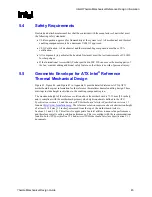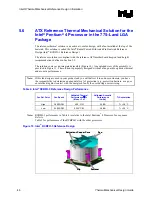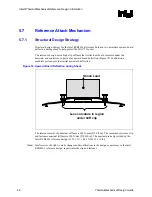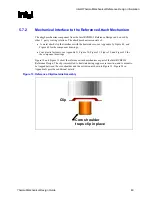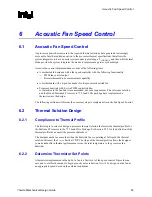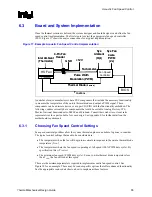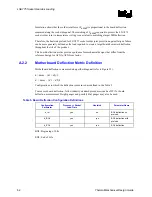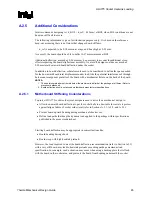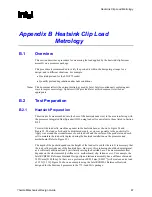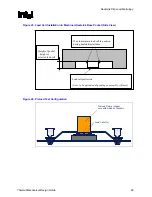
Acoustic Fan Speed Control
R
Thermal/Mechanical Design Guide
59
6.4
Combining Thermistor and Thermal Diode Control
There is no closed loop control between the FSC and the thermistor, but they work in tandem to
provide the maximum fan speed reduction. As discussed in Section 6.2.2, the thermistor
establishes the VSF curve. This curve will determine the maximum fan speed as a function of the
ambient temperature and by design provides a
Ψ
CA
sufficient to meet the thermal profile. The
FSC, by measuring the processor on-die thermal diode will command the fan to reduce speed
below the VSF curve in response to processor workload. Conversely if the processor workload
increases the FSC will command the fan via the PWM duty cycle to accelerate the fan up to the
limit imposed by the VSF curve.
Figure 21. Diode and Thermistor
F
an S
pee
d
(RPM)
Inlet Temperature (°C)
Full
Speed
30
38
Min.
Operating
Variable Speed Fan (VSF) Curve
Fan Speed
Operating Range
with FSC
34
Min %
F
an S
pee
d
(%
P
W
M
Du
ty Cycle
)
100 %
F
an S
pee
d
(RPM)
Inlet Temperature (°C)
Full
Speed
30
38
Min.
Operating
Variable Speed Fan (VSF) Curve
Fan Speed
Operating Range
with FSC
34
Min %
F
an S
pee
d
(%
P
W
M
Du
ty Cycle
)
100 %
6.5
Interaction of Thermal Profile and T
CONTROL
The Pentium 4 processor in the 775–land LGA packaged thermal specification is comprised of the
two parameters, T
CONTROL
and the maximum case temperature defined by the Thermal Profile.
The minimum requirement for thermal compliance is to ensure the thermal solution, by design,
meets the thermal profile.
If the system design will incorporate variable speed fan control, Intel requires monitoring the on-
die thermal diode to implement acoustic fan speed control. The value of the on-die thermal diode
temperature determines which specification must be met.
•
On-die Thermal Diode less than T
CONTROL
⎯
When the thermal solution can maintain the thermal diode temperature to less than
T
CONTROL
then the fan speed can be reduced.
•
On-die Thermal Diode equal to T
CONTROL
⎯
The PWM duty cycle must be = 100%
•
On-die Thermal Diode greater than T
CONTROL
⎯
The T
C
must be maintained at or below the Thermal Profile for the measured power
dissipation.
§
Содержание 640 - Pentium 4 640 3.2GHz 800MHz 2MB Socket 775 CPU
Страница 14: ...Introduction R 14 Thermal Mechanical Design Guide ...
Страница 38: ...Thermal Management Logic and Thermal Monitor Feature R 38 Thermal Mechanical Design Guide ...
Страница 52: ...Intel Thermal Mechanical Reference Design Information R 52 Thermal Mechanical Design Guide ...
Страница 60: ...Acoustic Fan Speed Control R 60 Thermal Mechanical Design Guide ...
Страница 72: ...Heatsink Clip Load Metrology R 72 Thermal Mechanical Design Guide ...
Страница 97: ...Mechanical Drawings R Thermal Mechanical Design Guide 97 Figure 48 Reference Clip Drawings Sheet 1 ...
Страница 98: ...Mechanical Drawings R 98 Thermal Mechanical Design Guide Figure 49 Reference Clip Drawings Sheet 2 ...
Страница 99: ...Mechanical Drawings R Thermal Mechanical Design Guide 99 Figure 50 Reference Fastener Sheet 1 ...
Страница 100: ...Mechanical Drawings R 100 Thermal Mechanical Design Guide Figure 51 Reference Fastener Sheet 2 ...
Страница 101: ...Mechanical Drawings R Thermal Mechanical Design Guide 101 Figure 52 Reference Fastener Sheet 3 ...
Страница 102: ...Mechanical Drawings R 102 Thermal Mechanical Design Guide Figure 53 Reference Fastener Sheet 4 ...
Страница 103: ...Mechanical Drawings R Thermal Mechanical Design Guide 103 Figure 54 Clip Heatsink Assembly ...
Страница 104: ...Mechanical Drawings R 104 Thermal Mechanical Design Guide Figure 55 Intel R RCBFH 3 Reference Solution Assembly ...

